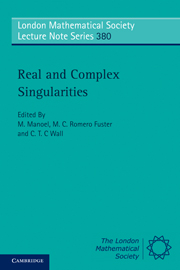Book contents
- Frontmatter
- Contents
- Preface
- 1 On a conjecture by A. Durfee
- 2 On normal embedding of complex algebraic surfaces
- 3 Local Euler obstruction, old and new, II
- 4 Branching of periodic orbits in reversible Hamiltonian systems
- 5 Topological invariance of the index of a binary differential equation
- 6 About the existence of Milnor fibrations
- 7 Counting hypersurfaces invariant by one-dimensional complex foliations
- 8 A note on topological contact equivalence
- 9 Bi-Lipschitz equivalence, integral closure and invariants
- 10 Solutions to PDEs and stratification conditions
- 11 Real integral closure and Milnor fibrations
- 12 Surfaces around closed principal curvature lines, an inverse problem
- 13 Euler characteristics and a typical values
- 14 Answer to a question of Zariski
- 15 Projections of timelike surfaces in the de Sitter space
- 16 Spacelike submanifolds of codimension at most two in de Sitter space
- 17 The geometry of Hopf and saddle-node bifurcations for waves of Hodgkin-Huxley type
- 18 Global classifications and graphs
- 19 Real analytic Milnor fibrations and a strong Łojasiewicz inequality
- 20 An estimate of the degree of ℒ-determinacy by the degree of A-determinacy for curve germs
- 21 Regularity of the transverse intersection of two regular stratifications
- 22 Pairs of foliations on surfaces
- 23 Bi-Lipschitz equisingularity
- 24 Gaffney's work on equisingularity
- 25 Singularities in algebraic data acquisition
9 - Bi-Lipschitz equivalence, integral closure and invariants
Published online by Cambridge University Press: 07 September 2011
- Frontmatter
- Contents
- Preface
- 1 On a conjecture by A. Durfee
- 2 On normal embedding of complex algebraic surfaces
- 3 Local Euler obstruction, old and new, II
- 4 Branching of periodic orbits in reversible Hamiltonian systems
- 5 Topological invariance of the index of a binary differential equation
- 6 About the existence of Milnor fibrations
- 7 Counting hypersurfaces invariant by one-dimensional complex foliations
- 8 A note on topological contact equivalence
- 9 Bi-Lipschitz equivalence, integral closure and invariants
- 10 Solutions to PDEs and stratification conditions
- 11 Real integral closure and Milnor fibrations
- 12 Surfaces around closed principal curvature lines, an inverse problem
- 13 Euler characteristics and a typical values
- 14 Answer to a question of Zariski
- 15 Projections of timelike surfaces in the de Sitter space
- 16 Spacelike submanifolds of codimension at most two in de Sitter space
- 17 The geometry of Hopf and saddle-node bifurcations for waves of Hodgkin-Huxley type
- 18 Global classifications and graphs
- 19 Real analytic Milnor fibrations and a strong Łojasiewicz inequality
- 20 An estimate of the degree of ℒ-determinacy by the degree of A-determinacy for curve germs
- 21 Regularity of the transverse intersection of two regular stratifications
- 22 Pairs of foliations on surfaces
- 23 Bi-Lipschitz equisingularity
- 24 Gaffney's work on equisingularity
- 25 Singularities in algebraic data acquisition
Summary
Abstract
In this note we relate several different ways of looking at an infinitesimal notion of bi-Lipschitz equisingularity. In the case of curves we show how invariants related to these notions can be used to tell if a family is bi-Lipschitz equisingular.
Introduction
The study of bi-Lipschitz equisingularity was started by Zariski [22], Pham and Teissier [18], [19], and was further developed by Lipman [13], Mostowski [14], [15], Parusinski [16], [17], Birbrair [2] and others.
In this note, we begin the study of bi-Lipschitz equisingularity from the perspective of our previous work on Whitney equisingularity. In the approach of that work, the study of the equisingularity condition is developed along two avenues. One direction is the study of the appropriate closure notion on modules and applying it to the Jacobian module of a singularity [4]. The other direction is through the study of analytic invariants which control the particular stratification condition [5]. The interaction between the two approaches is useful in understanding each approach.
In section two of this paper, we work on the first approach, looking to the hypersurface case, and to similar constructions for motivation. The construction which seems most promising, defining the saturation of I via the blow-up of X by I, is the analogue of a construction used to study the weak sub-integral closure of an ideal in [11], written with Marie Vitulli.
In section three, we apply the theory of analytic invariants to describe when a family of space curves is bi-Lipschitz equisingular.
- Type
- Chapter
- Information
- Real and Complex Singularities , pp. 125 - 137Publisher: Cambridge University PressPrint publication year: 2010
- 6
- Cited by

